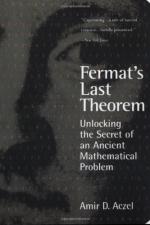|
This section contains 1,209 words (approx. 5 pages at 300 words per page) |

|
Fermat's last theorem is one of the most famous theorems of mathematics. It was first stated by the brilliant amateur mathematician Pierre de Fermat, but it wasn't proved until more than 350 years later. Over the centuries it provided a tantalizing challenge to great mathematicians and amateurs alike, but it did not yield to proof until 1994, when a proof by Princeton mathematician Andrew Wiles was accepted by the mathematical community as correct.
Although it turned out to be one of the most challenging problems in mathematics, Fermat's last theorem is exceptionally easy to state. It says that whenever n is a whole number bigger than two, the equation x^n + y^n = z^n has no non-zero solutions x, y, and z among the whole numbers.
Fermat's statement was found by his son as a marginal note that the great mathematician had made in his...
|
This section contains 1,209 words (approx. 5 pages at 300 words per page) |

|


